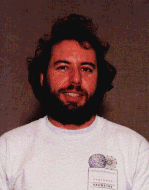
Director of the Center
(This page is like a cathedral: always under reconstruction ;-)
Kusner's Mathematical Giftshop
Interested in turning a sphere inside-out? Here's a link to my note On The Minimax Sphere Eversion. A more complete account of this is about to appear (replete with color graphics) in the proceedings of the 1995 Berlin Conference on geometry and graphics. If you can't wait to see what is going on, visit our LATERNA Mathemagica website.
How about soap bubbles, or perhaps more accurately, "splashes" of liquid that can be described as complete, embedded constant mean curvature (CMC) surfaces? After the Delaunay surfaces, and the dihedrally symmetric examples discovered by Hermann Karcher and Karsten Brauckmann, the simplest genus 0 examples have 3 ends and isosceles symmetry or 4 ends and either rhombic or rectangular symmetry. (One of my students, Jorgen Berglund, wrote his thesis on the latter surfaces.) The isosceles, rhombic and rectangular CMC surfaces each form 2-dimensional moduli spaces, which Brauckmann and I invesitgated in our paper On the Moduli Spaces of Embedded Constant Mean Curvature Surfaces with Few Ends and Special Symmetry, which has appeared in Manuscripta Math (1999).
We are now working with John Sullivan to understand the general 3-ended case - triunduloids - as a kind of "fundamental interaction" for building up more general CMC surfaces. We are also looking at a new phenomenon which occurs for 4-ended surfaces, a kind of twisting behavior that introduces torques into the picture. One consequence of our work on rhombic surfaces is strong evidence for the conjecture: the moduli spaces of genus 0 CMC surfaces with any fixed number of ends is connected (we have proven this in the case of coplanar surfaces)!
Here's an early version of the triunduloids story, which can be compared with the preprint versions at the math arXiv, and with the printed version in Crelle's Journal for Pure (Reine) and Applied (Angewandt) Mathematics (2003).
Check out this link to my solder page at the National Institute of Standards and Technology, where I have done some consulting on optimal design for electronics components interconnects - the shape of solder joints is really part of the theory of prescribed mean curvature surfaces. Here's the local version of that page, just in case NIST's page is down.
Here's the older MSRI dg-ga archive version of my memoir with Nick Schmitt, and here's the updated revision retitled The Spinor Representation of Surfaces in Space (.ps format, 710KB) or (.dvi format, 210KB). I lectured on this paper, and on recent work I have done on Natural Lagrangian and Symplectic Structures for Moduli Spaces of Constant Mean Curvature Surfaces and Related Geometric Variational Problems, in the graduate course I gave while visiting the University of Minnesota in Spring 1996.
In May 1994 I spoke at the Conference on Elliptic and Parabolic Methods in Geometry in Minneapolis on the existence of surfaces of every genus minimizing the square-mean-curvature integral. You can get the whole volume of EPMG proceedings from AKPeters.
And in August 1993 I lectured at the Georgia International Topology Conference - the (essentially) final version (without stereoscopic knot catalog - these images can be found here ) of Moebius Energies of Knots and Links... with John Sullivan is now available. The full conference proceedings is available from International Press. A colleague of ours in Vancouver, Dr. Rob Scharein, has created some nice
software, KnotPlot, for creating and displaying knots.
Sullivan and I are also working on the mathematical analysis of foams .
Address
1435G Lederle Graduate Research Tower
Department of Mathematics
University of Massachusetts at Amherst
Amherst MA 01003
USA
Phone 413 545 6022
Secretary 413 545 2812
Fax 413 545 1801
Electronic Mail rob@gang.umass.edu
All material on this website is Copyleft* by Rob Kusner.